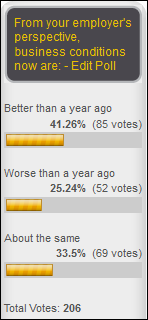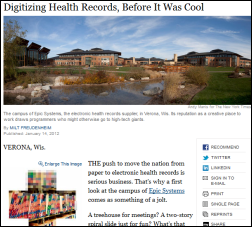The sentence was "most people just go to Epic UGM" - that's people going to Epic's annual user conference and…
Monday Morning Update 1/16/12
From Barry Goode: “Re: 5010. I’m glad to dish out all the dirt I know as a vendor. Big picture, it’s been a LOT easier and less troublesome than we expected. Most of our payers and intermediaries have been really good. Our clients have a 99+% clean claim rate. The clearinghouses have been far more troublesome than the payers as a rule, which is pathetic because it’s their primary business. A good clearinghouse having trouble with a particular payer should be able to EASILY resubmit claims in the 4010 format in order for the practices to be paid while issues are worked out. The deadline was moved! Although the clearinghouses are to blame for some of the trouble, the real culprits will soon be the state Medicaids. Some of them have yet to even indicate when they will be ready for testing.”
From Rumble: “Re: Partners. Heard they’re making that big decision by April 1. Why use that date? Push it out a day or two, jeez …”
From HIPAA Hound: “Re: how doctors die. Here’s another article, a tad longish, but interesting. My wife and I are both of this mind, and we have our living wills/advance directives on file and our durable POAs ready if necessary. In my opinion, too much technology in the hands of the uninformed or emotionally involved (that’s not the right word, but I can’t seem to call the correct one to mind) is what runs US healthcare costs out of sight. My two cents.” I’m no expert, but Americans seem to be uniquely culturally incapable of accepting death. We’re so used to endless opportunity (at least until recently), unlimited science, and never-ending self-actualization that to just admit that your number is up never happens. It’s not just the elderly – every hospital I’ve worked in spends millions saving wildly premature babies weighing a pound or two. My conscience hasn’t resolve the question of whether that’s the best use of increasingly limited healthcare resources, especially when you look at some of the families and try to decide what that baby will be going home to after unbelievably expensive months in the NICU.
From The PACS Designer: “Re: iPhone’s 5th. It’s had to believe, but the iPhone just celebrated its 5th anniversary. When it was first released, virtually no one predicted it would dominate the marketplace and outdo other smart phones in popularity. Healthcare has always been a sweet spot for Apple products, so that’s why there’s always a place for almost every new Apple product introduction. The first iPhone was 1.16 cm thick and had a 3.5″ widescreen touchscreen display with multi-touch support, 8GB of RAM, Bluetooth, WiFi, and a 2 megapixel camera.” I couldn’t easily find the link, but an HIStalk poll I ran when the iPhone came out found that readers mostly thought it would have little influence on healthcare. As a vendor, how would you like to have a product that’s in such high demand that Chinese consumers are willing to attack humorless police and criticize their government when the local Apple store doesn’t open on time? Maybe financially irresponsible countries should consider slapping on iPhone tax like the cigarette tax, knowing that people are addicted. I floated a similar to proposal to a slightly interest audience (Mrs. H) while in the airport this weekend – revenue-happy airlines that are even charging passengers for boarding ahead of their assigned zone should charge the idiots that congregate around the boarding lane before their turn, blocking the path of those trying to board as called. You can sit for free, or obstruct for a fee.
I’ve whisked Mrs. HIStalk away for a rare long weekend as I attempt to temporarily recover from the onslaught of HIMSS-related HIStalk work (not to mention work at my hospital) that has been testing my mental and physical capabilities. I’ll keep this post brief rather than just bag it completely or dump it on Inga to write, pecking it out on my small HP laptop on modestly good hotel wireless. Your regularly scheduled verbosity will resume Tuesday evening. In the mean time, Mrs. H and I are tooling around in a really cool Mustang convertible (a rental – something I’ve always wanted to do), eating in good restaurants, working out, and relaxing. Then it’s back for the final assault before the conference.
I’m fascinated with Vince’s HIS-tory this week because he gives some rare and fun background on a couple of industry long-timers: Judy Faulkner and Frank Poggio. His series always reminds me that it’s about the people more than the companies.
Here’s my final thought on CMS’s Meaningful Use numbers. I’m pretty sure ONC’s point was to show what a great job it’s been doing in getting providers to use EHRs, and their information (not surprisingly) seems to support that. I’m not sure why they included vendor information, though. They should have known that everybody would try to over-analyze and massage the skimpy data to gain competitive advantage. That focus has actually caused many folks to miss the point that the adoption curve is moving sharply upward, which is ONC’s real job rather than feeding the competitive EHR market frenzy. As a provider, your mileage will undoubtedly vary no matter what someone else’s numbers show. And the next set of numbers will provide a much-needed data point: does adoption seem to be increasing, or has it peaked?
I was interested to hear that Adventist Health is putting Cerner in its ambulatory locations. I didn’t know that, at least according to one reader, they’re displacing Epic ambulatory. That’s how it should work, of course – the hospital system generally drives the choice of the outpatient system, not vice versa, although Epic has benefited greatly from customers who don’t find that to be an acceptable choice given their incumbent vendors. I was thinking that Loma Linda University Medical Center might be impacted since they announced an Epic inpatient decision not long ago, but I guess they aren’t part of Adventist Health like I thought I remembered.
Thanks to everyone who signed up for HIStalkapalooza invitations. The signups have been closed and invitations will be e-mailed out shortly to the folks we can accommodate (we had around 1,000 invitation requests, so unfortunately we can’t send everybody an invitation.) Thanks, too, to everyone who voted in the HISsies – I’ve closed that voting as well.
The economy is looking better to a good number of the folks responding to my most recent poll. New poll to your right: CMS released Meaningful Use numbers. How are attestations running compared to what you expected?
The New York Times writes up Epic in its business section. It’s not a particularly insightful or in-depth piece, but they did apparently interview Judy although the article has few quotes. It does include some interesting statistics: Epic has 260 customers, 35 of which signed on last year. Their software will cover 127 million patients next year. The company has 5,100 employees and will hire another 1,000 this year. Revenue for 2011 is expected to come in at $1.2 billion, up 45% from 2010. It also mentions a retired UW professor of psychiatry who was an original Epic investor and who sits on the company’s board, the first mention I’ve seen that the company has investors or a board. It would be interesting to know what she invested and what that investment is worth now, although obviously private company shares are illiquid, making valuation (and selling) tricky.
Cerner hits the 10,000 employee mark.
This week’s employee e-mail from Kaiser Chairman and CEO George Halvorson talks up walking, with nearly 30,000 of KP’s employees enrolled in its walking programs. KP has developed an EveryBody Walk! app to help people develop a walking plan and find walking routes.
Just in case you’re Googling for old HIStalk posts prior to 2007, they’re gone, at least temporarily. The blog service I used for HIStalk from 2003 until 2007 has gone belly-up, which isn’t surprising since it was really run more like a geek’s electronic bulletin board than a professional service, so WordPress killed it off easily (that threat and a couple of issues I had led me to abandon it years ago). I have an XML backup that can supposedly be imported into WordPress, so if I see benefit to putting the old stuff back online, I’ll hire someone to port it over. I feel some loss – I spent a ton of time and energy crafting those old posts.
Akron Children’s Hospital names Amy Maneker MD as CMIO to oversee its Epic implementation. She previously held a similar role with Rainbow Babies and Children’s Hospital in Cleveland.
Inga ran across this on Facebook. RelayHealth donates its $50,000 prize for winning the VA’s Blue Button for All Americans contest to the Wounded Warrior Project, which helps wounded service members.







Sorry to hear of your loss of your work due to soemthing as simple and common as a bankruptcy.
And of course, that will never happen to patients’ electronic medical records.
I’ve heard Loma Linda University Medical Center is an odd duck. In relation to Adventist, it’s not necessarily an owned facility – but lightly affiliated in some manner. Nonetheless, they’re still flipping the switch to Epic.
re: accepting death
That’s why I got out of trauma care – we were saving vegetables because we technologically could. There was little, if any, thoughtful regard to a future quality of life.
Re: It also mentions a retired UW professor of psychiatry who was an original Epic investor and who sits on the company’s board, the first mention I’ve seen that the company has investors or a board. It would be interesting to know what she invested and what that investment is worth now,..
Well, since Vince did such a nice piece about HMDS and didn’t mention any of our missteps…I’ll fill in some of the blanks and Mr. H’s query about Epic.
As I recall the psych department at UWH was building a mental mental health data base primarily for clinical research. When we at UWH decided not to pick up the psych computer budget as their grant ran out, about four of five of the psych docs including the department chairman, formed Epic as a private company. The plan was to sell the mental health data tool to county /community mental health centers to help fund the research they were doing. As I remember, back then things were pretty tough going for many years, as with many small software startups. Somewhere in the early 1990’s long before Epic hit it big, the original investors wanted out and the baord majority was trying to sell the company. Judy who at the time was a small minority /employee owner basically, thru an LBO, bought out all the major investors and became the majority stock holder. A small number kept there remaing little equity piece and that became the board. I do not know the makeup of today’s board, but suffice it to say its likely role is advisory.
I think the real back story here is Judy’s willingness to buy out all her major investors and take a very large risk long before Epic hit it big.
Re: Loma Linda
There are a few Adventist multi-hospital organizations. Loma Linda University Medical Center is one of those. Almost all use Cerner, however Loma Linda is moving to Epic now. Each of the organizations makes their own independent decisions, but all are joined by their faith-based mission, vision, and values. Loma Linda is the only one that is an academic medical center with its own school of medicine.